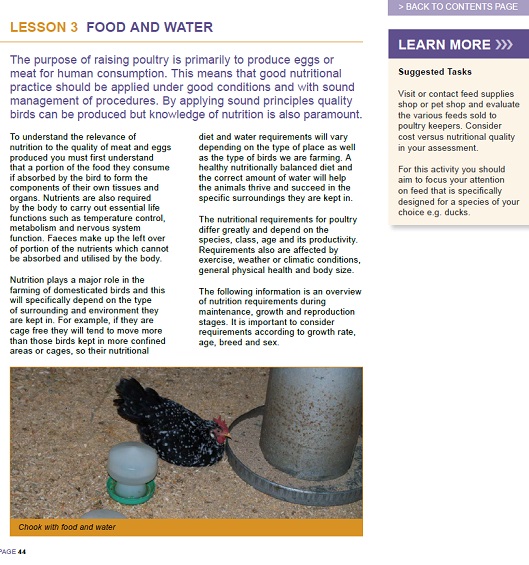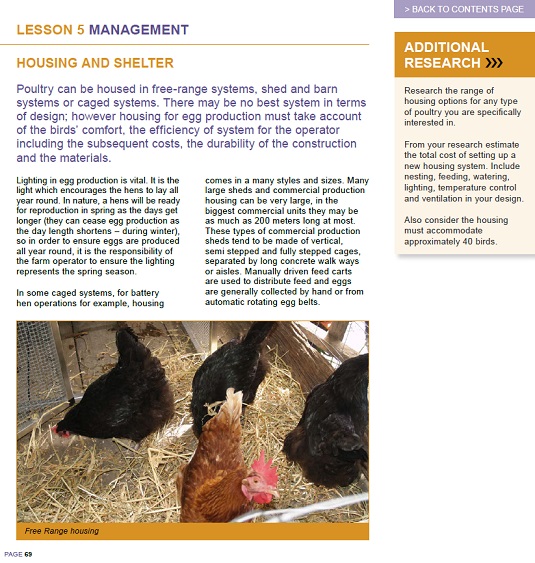Sneak Peek
This is a self Paced 20-hour course to help you understand and Become an Expert at Raising and Caring for Poultry.
If you are considering owning chickens or other poultry, you should start with the Caring for Chickens and Other Poultry short course. This course will help you understand everything that you need to know about different varieties of poultry, breeds, how you can care for them.
If you are considering purchasing a small flock for your backyard pet, or a more serious business venture, everything you need to know. You may even work in a poultry or a pet care business and would like to gain more knowledge to support your career.
This short course covers 6 lessons that explores the history and origins of chickens and other poultry, the overall nature of caring for chickens, recognising breeds, the fundamentals of feeding and nutrition, health care, general management of a flock and the industry services and opportunities. It is designed to take around 20 hours to complete from start to finish!
Like all of our animal and agricultural courses, this course is founded on research from history, agriculture, science and business. A wealth of information comes from academic writers who have years of knowledge and experience working with animals including poultry.
At the end of each lesson, you will be given a short interactive test to undertake, which will provide an indication of how your learning is progressing. Upon completing the very last lesson, you will be offered a more thorough automated test or examination. This final assessment can be undertaken at a time that suits you. If you achieve an overall pass, you will be able to obtain a "certificate of completion" with your name and completion date on it.
Our 20 hour courses are self paced and will help you understand a topic in a short amount of time.
COURSE CONTENT- What do you learn?
THE LESSONS
LESSON 1 SCOPE AND NATURE OF DOMESTICATED POULTRY
 A brief history
A brief history
Keeping poultry – profit or pleasure
Chickens
Turkeys
Ducks
Don’t buy sick birds
How to help hatchings chicks
How to revive ‘dead’ hatchlings
Poultry products and uses
Value adding to poultry products
Concerns for human health
Lesson 1 additional reading
Review what you have been learning
LESSON 2 BREEDS
Basic nomenclature
Categories of breeds
Breeds
Chicken (fowl) classification
Lesson 2 additional reading
Review what you have been learning
LESSON 3 FOOD AND WATER
Feeding for stages – starter, growth, maintenance
Nutrition during reproduction
Digestive system
Nutrients from feed
Water requirements
Favourite treats
Feeding fowls
Feeding turkeys
Feeding ducks
Feeding geese
Lesson 3 additional reading
Review what you have been learning
LESSON 4 HEALTH
A definition of health
First aid kit for poultry
Administering medication by syringe
Common poisonous household products
General basic care
Common diseases affecting poultry
Parasites
Lesson 4 additional reading
Review what you have been learning
LESSON 5 MANAGEMENT
Housing and shelter
Managing waste
Environmental issues
Regulations for keeping poultry
Management procedures for breeding
Meat production procedures
Lesson 5a additional reading
Lesson 5b additional reading
Review what you have been learning
LESSON 6 THE POULTRY INDUSTRY
Working in the poultry industry
Farm management – egg, meat or breeder
Lesson 6 additional reading
Review what you have been learning
FINAL ASSESSMENT
Support along the Way from Experts
You have access to expert tutors through our student help desk all the time you are studying this course. Our school maintains help desks in both of our offices -in Australia and the UK; and has staff on duty five days a week manning phones, online chat and emails. Any questions that you have about what you are studying will be dealt with promptly (usually the same working day, often immediately).
- If there is something you read or research that you don't understand, ask for help.
- If you want to learn more about something you encounter through these studies, have a conversation with one of our faculty tutors
- If you need direction to find more information, ask
- If you need advice on moving forward with your work, career or studies after the course ask. (Free career and business advice is part of the service provided to all of our graduates).
SAMPLE COURSE PAGES


LEARN TO MANAGE POULTRY BOTH AS PETS, OR ON A FARM
The way we manage poultry can vary a great deal; depending upon how many you are keeping, why you are keeping them, the breeds you choose, and other factors. This course is relevant to all of these and any other situation. It will provide a fundamental understanding of the husbandry practices, and the different contexts you may find yourself in.
How Do You Introduce New Chickens to Your Flock?
Introducing new birds to your already established flock can be very stressful for both the old and new birds. Established flocks of chickens usually have a pecking order, where each hen knows her place. New chickens disrupt the order and can cause social unrest.
Quarantine is also extremely important. If you have a flock of healthy, happy birds you don’t want to ruin that by not properly quarantining the new birds. You should keep your new chickens in quarantine for four weeks. Now this may seem like a long time and a bit of a hassle; however it is much more of a hassle if your whole flock gets sick and you have to seek treatment, or may even lose birds.
If you are introducing baby chicks you should make sure they are big enough to defend themselves from older birds, they should be at least 6 weeks old.
First introduce them so that the chickens (old and new) can see each other, but can’t physically access each other. This will allow them to work out the pecking order without having to get physically pecked. Do this for a week. They should be able get visual cues from each other to be able to work out the pecking order.
Introducing Chickens to a Garden
One of the main concerns people have when getting chickens is how to stop chickens from ruining your garden. Chickens love to dig around in the garden and can be great for pest control; however some breeds can be more destructive than others. Traditionally smaller breeds (such as silkies and bantam varsities) are a little gentler on your garden than larger, stronger breeds.
You should take into consideration how many chickens your backyard can carry comfortably. Chickens are good foragers, most lawns are able to cope with two or three chickens grazing however if you have too many chickens you run the risk of overgrazing. Depending on the size of your yard and chicken coop you could try rotational or limiting how much time they spend out of their coop foraging.
Well established trees or shrubs usually won’t be affected by a chicken digging around in the top soil, however flowers or seedlings may not get off so lucky. It’s a good idea then the make sure there are good quality barricades or dividers between you young or delicate plants.

Are any Breeds more Docile?
Docile chickens are less likely to be spooked or flighty around pets or children, which means they are more likely to get on with them.
Silkie-bantams
Children love the look of these fluffy, soft birds. They are a smaller more manageable size and they love to be handled. They have a sweet nature and lay about 120 smaller sized eggs a year. Being calm and outgoing means they can get along well with other pets too, though the smaller size and fluffy look can also be tempting for dogs and cats with a high prey drive.
ISA Browns
They are docile, friendly chickens that enjoy spending time with their human families. They are usually not as flighty around children and other pets. They are low maintenance, hardy and are exceptional layers. They are a large enough size that they are less likely to be attacked than smaller birds.
WHO IS THIS COURSE FOR?
- Property owners seeking to become more self sufficient
- Anyone thinking about keeping poultry as pets
- Anyone working in the poultry industry who has never formally studied poultry
- Anyone with an interest in, or passion for poultry
How does this course work?
You can enrol at any time. Once you have paid for the course, you will be able to start straight away. Study when and where you like. Work through at your own pace.
You can download your study-guide to your smart phone, tablet or laptop to read offline.
There are automated self-assessment tests you can complete at the end of each lesson. You can attempt these as many times as you wish and each time, upon completion, you can see your results. You will need internet access to complete the self assessment tests.
At the end of the course, you are presented with a large assessment which can be attempted online, anywhere, anytime. If you achieve a 60% pass in the exam; you immediately receive a downloadable certificate of completion with your name on it. If you do not achieve a 60% pass rate, you can contact us to re-sit your exam. ( email- admin@acs.edu.au )
Contact us at anytime if you have any issues with the course. admin@acs.edu.au